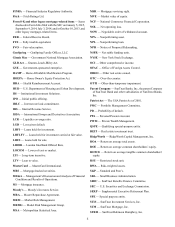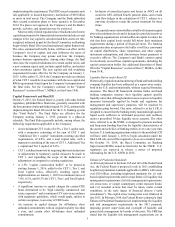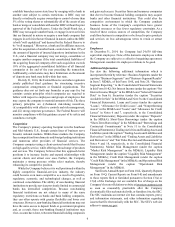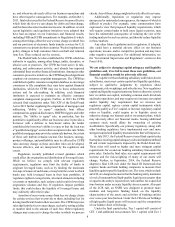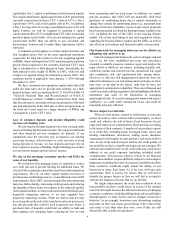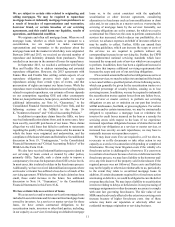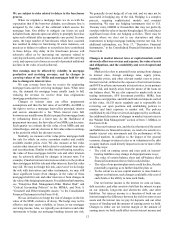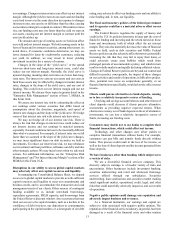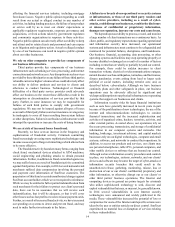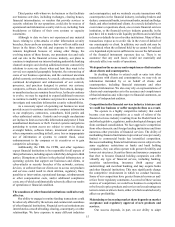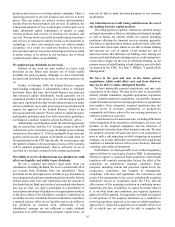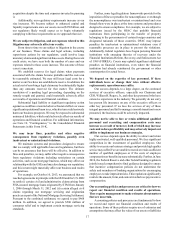SunTrust 2014 Annual Report Download - page 32
Download and view the complete annual report
Please find page 32 of the 2014 SunTrust annual report below. You can navigate through the pages in the report by either clicking on the pages listed below, or by using the keyword search tool below to find specific information within the annual report.9
capital plus Tier 2 capital constituting total risk-based capital.
The required minimum capital requirements will be greater than
currently required and include a CET 1 ratio of 4.5%; a Tier 1
capital ratio of 6%, and a total capital ratio of 8%. In addition,
a Tier 1 leverage ratio to average consolidated assets of 4% will
apply. Further, we will be required to maintain a capital
conservation buffer of 2.5% of additional CET 1 after a transition
period to phase-in the buffer. If we do not maintain the capital
conservation buffer, then our ability to pay dividends and
discretionary bonuses and to make share repurchases will be
restricted.
A transition period applies to certain capital elements and
risk weighted assets. One of the more significant transitions
required by the final rules relates to the risk weighting applied
to MSRs, which will impact the CET1 ratio during the transition
period when compared to the currently disclosed CET1 ratio
that is calculated on a fully phased-in basis. Specifically, the
fully phased-in risk weight of MSRs is 250%, while the risk
weight to be applied during the transition period is 100%. The
transition period is applicable from January 1, 2015 through
December 31, 2017.
We have estimated our regulatory capital under Basel III
under the final rules and we provide that estimate, on a fully
phased-in basis, and a reconcilement to U.S. GAAP in Table 34,
“Selected Financial Data and Reconcilement of Non-U.S.
GAAP Measures” in Item 7, MD&A, in this Form 10-K. Note
that this estimate is consistent with our interpretation of the final
rule and ambiguities in the final rule or other interpretations of
the final rule could result in a larger measure of RWAs and
consequently a lower CET 1 ratio.
Loss of customer deposits and market illiquidity could
increase our funding costs.
We rely heavily on bank deposits to be a low cost and stable
source of funding for the loans we make. We compete with banks
and other financial services companies for deposits. If our
competitors raise the rates they pay on deposits, our funding
costs may increase, either because we raise our rates to avoid
losing deposits or because we lose deposits and must rely on
more expensive sources of funding. Higher funding costs reduce
our net interest margin and net interest income.
We rely on the mortgage secondary market and GSEs for
some of our liquidity.
We sell most of the mortgage loans we originate to reduce
our credit risk and to provide funding for additional loans. We
rely on GSEs to purchase loans that meet their conforming loan
requirements. We rely on other capital markets investors to
purchase non-conforming loans (i.e., loans that do not meet GSE
requirements). Since 2007, investor demand for nonconforming
loans has fallen sharply, increasing credit spreads and reducing
the liquidity of those loans. In response to the reduced liquidity
in the capital markets, we may retain more nonconforming loans,
negatively impacting reserves, or we may originate less,
negatively impacting revenue. When we retain a loan not only
do we keep the credit risk of the loan but we also do not receive
any sale proceeds that could be used to generate new loans. A
persistent lack of liquidity could limit our ability to fund and
thus originate new mortgage loans, reducing the fees we earn
from originating and servicing loans. In addition, we cannot
provide assurance that GSEs will not materially limit their
purchases of conforming loans due to capital constraints or
change their criteria for conforming loans (e.g., maximum loan
amount or borrower eligibility). As previously noted, proposals
have been presented to reform the housing finance market in the
U.S., including the role of the GSEs in the housing finance
market. The extent and timing of any such regulatory reform
regarding the housing finance market and the GSEs, as well as
any effect on our business and financial results, are uncertain.
Our framework for managing risks may not be effective in
mitigating risk and loss to us.
Our risk management framework seeks to mitigate risk and
loss to us. We have established processes and procedures
intended to identify, measure, monitor, report and analyze the
types of risk to which we are subject, including liquidity risk,
credit risk, market risk, interest rate risk, operational risk, legal
and compliance risk, and reputational risk, among others.
However, as with any risk management framework, there are
inherent limitations to our risk management strategies as there
may exist, or develop in the future, risks that we have not
appropriately anticipated or identified. The recent financial and
credit crisis and resulting regulatory reform highlighted both the
importance and some of the limitations of managing
unanticipated risks. If our risk management framework proves
ineffective, we could suffer unexpected losses and could be
materially adversely affected.
We are subject to credit risk.
When we lend money, commit to lend money or enter into
a letter of credit or other contract with a counterparty, we incur
credit risk, which is the risk of losses if our borrowers do not
repay their loans or our counterparties fail to perform according
to the terms of their contracts. A number of our products expose
us to credit risk, including loans, leveraged loans, leases and
lending commitments, derivatives, trading assets, insurance
arrangements with respect to such products, and assets held for
sale. As one of the nation's largest lenders, the credit quality of
our portfolio can have a significant impact on our earnings. We
estimate and establish reserves for credit risks and credit losses
inherent in our credit exposure (including unfunded credit
commitments). This process, which is critical to our financial
results and condition, requires difficult, subjective and complex
judgments, including forecasts of economic conditions and how
these economic conditions might impair the ability of our
borrowers to repay their loans. As is the case with any such
assessments, there is always the chance that we will fail to
identify the proper factors or that we will fail to accurately
estimate the impacts of factors that we do identify.
We might underestimate the credit losses inherent in our
loan portfolio and have credit losses in excess of the amount
reserved. We might increase the allowance because of changing
economic conditions, including falling home prices and higher
unemployment, or other factors such as changes in borrower
behavior. As an example, borrowers may discontinue making
payments on their real estate-secured loans if the value of the
real estate is less than what they owe, even if they are still
financially able to make the payments.


